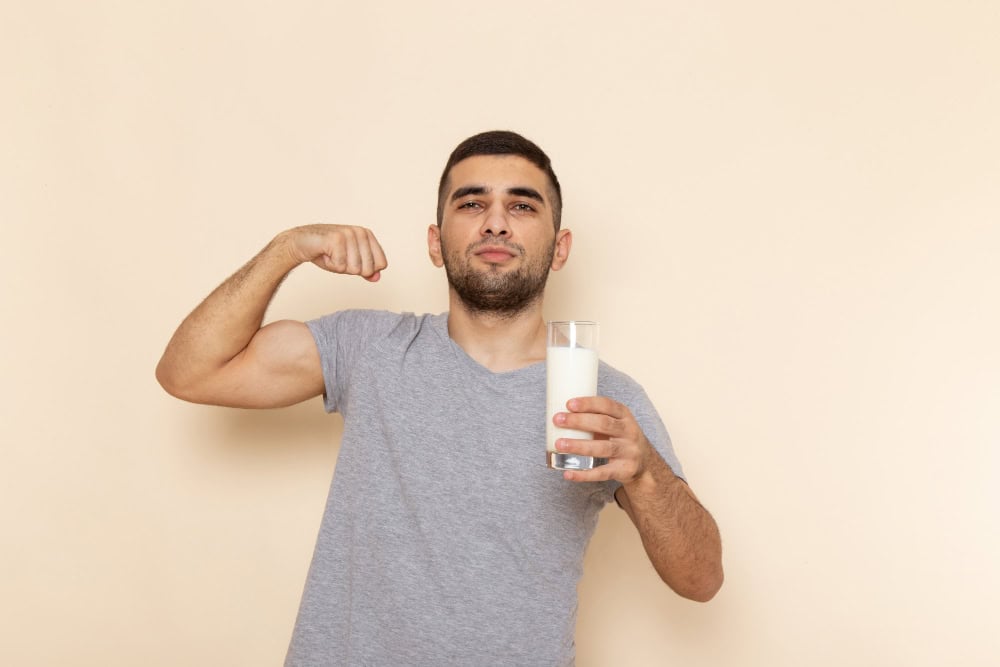
Many of us believe that drinking enough milk and eating paneer automatically keeps the bones strong. But did you know that if your vitamin D is low, your body cannot absorb calcium properly? In India, nearly 70% of the population has vitamin D deficiency [2], and they do not even know about it. So, which nutrient should you prioritise between calcium and vitamin D?
If you are also unsure about your vitamin D levels or “feeling weak in the knees”.
Many people take supplements without knowing what they actually need. You may also have various confusing questions in your mind. In this article, we will dive into the roles of calcium and vitamin D and talk about why both are often misunderstood.
Roles Explained: Calcium and Vitamin D
Calcium – The Structural Mineral

Calcium is the most abundant mineral in the body. It can build and maintain strong bones and teeth, support muscle contractions, nerve transmission, and even help with blood clotting. Without enough calcium, muscles and nerves may not function optimally, leading to cramps or weakness. With insufficient calcium in the body, Bone can lose density, causing risks of fracture or osteoporosis (a disease that makes your bones brittle and weak)
Vitamin D – The Hormone-Like Nutrient

Vitamin D acts more like a hormone than a simple nutrient. One of its functions is to help the intestine absorb calcium and maintain proper levels of calcium and phosphorus in the body. This ensures that the bones and muscles can get what they need. Vitamin D can also support immune health, the strength of your muscles, and can even influence your mood and cognition.
Signs Of Low Calcium and Vitamin D
You may experience:
– Numbness or tingling in hands and feet
– Brittle nails or weak hair
– Frequent muscle cramps
– Fatigue or feeling low on energy
– Bone pain, especially in the legs or back
Learn How Calcium and Vitamin D Work Together

“Is calcium more important or is vitamin D?” This question might be stuck in your mind. Well, you cannot compare Calcium and Vitamin D as your body loves both, but for different reasons. Without sufficient vitamin D, the body struggles to absorb calcium – even if you consume plenty.
So, both matter, but if forced to pick the starting point, it’s likely to be vitamin D. As you can have all the calcium you want, but without adequate vitamin D, your body might still face deficiencies.
How Much Calcium and Vitamin D Does One Need

According to various health guidelines, given below are the daily requirements for calcium and vitamin D.
Calcium Requirements:
| Age Group | Daily Requirements |
| Kids and Adolescents (9-18 years) | Higher than adults (~1000-1300 mg/day) |
| Adults (19-50 years) | ~1000 mg/day |
| Men above 70 & Women above 50 years | ~1000-1200 mg/day (higher than adults) |
Vitamin D Requirements:
| Age Group | Daily Requirements |
| Adults | ~600 IU/day (15µg) |
| Other Adults (>70 years) | Higher than 600 IU/day (may be suggested to have 800 IU/day) |
India’s ICMR (Indian Council of Medical Research) guidelines largely align with these recommended intake levels. Individual needs may vary according to absorption, dietary patterns, sun exposure, and overall health.
One should always be aware that “more” is not always better. Exceeding safe limits of both can cause harm. For adults, the tolerable limits are ~2000 mg/day and ~4000 IU/day, respectively.
How To Get Calcium and Vitamin D?

Because of the busy and sedentary lifestyle and bad food choices, the regular requirement is also not being fulfilled. So, focus on:
Dietary and Other Sources: Milk, paneer, yoghurt, ragi, leafy greens, sesame seeds, etc. – all foods are rich in calcium. Whereas egg yolks, fortified foods (milk, cereals), fatty fish, and primarily sunlight are the sources of vitamin D.
Lifestyle Changes:
– Avoid high sodium, as it can interfere with calcium retention.
– Get outdoors, and make getting sunlight a habit.
Supplements: Can be considered when you are an office worker, don’t get enough sunlight, are a vegetarian, or see signs of deficiency. These can work as a safety net when your health is exponentially degrading by filling dietary or exposure gaps.
At TATA 1mg, get all the supplements you need with just a click!
Remember, supplements should only be taken under proper medical guidance.
Risks of Too Much or Too Little

When you have a deficiency, you may experience possible muscle weakness, weaker bones, and an increased risk of fractures. You can also develop osteoporosis due to a calcium deficiency or osteomalacia (a condition characterized by softening of the bones) resulting from a vitamin D deficiency.
When you have an excess of both, it can cause different risks. Excess calcium can increase the risk of kidney stones, gastrointestinal issues, and calcification of soft tissues. At the same time, too much vitamin D can cause hypercalcemia, arrhythmias, and kidney damage.
Quick Tips to Improve Both Calcium and Vitamin D
- Work out your diet: Aim for ~1000 mg/day of calcium and ~600 IU/day of vitamin D through foods or sunlight.
- Exercise: Try to include weight and strength training exercises, as they improve bone health.
- Make sunlight an essential habit: Walking for a few minutes early in the morning outdoors can help get the Vitamin D your body is begging for. By putting effort into it, you can make it a part of your daily routine.
- Avoid Caffeine: If you can, then try to limit your caffeine intake, as it can reduce calcium absorption.
- Check with your doctor or healthcare provider: Always consult a specialist before you take any supplements or make major lifestyle changes. Especially if you already have any underlying health condition related to the kidneys or heart, or if you take any medicines.
- Don’t chase high doses or supplements blindly: Avoid going above the recommended upper safe limits, unless your doctor suggests you do so.
FAQs
Q. Which is better to take, calcium or vitamin D?
Both calcium and vitamin D are important, but not interchangeable. Calcium builds bones, while vitamin D helps your body absorb it. If your diet is low in calcium and you have low vitamin D, you may need both together based on your doctor’s advice.
Q. Can you absorb calcium without vitamin D?
Without vitamin D, you cannot absorb calcium well. As vitamin D increases intestinal absorption of calcium, it is quite important for the efficiency of calcium absorption. Even if you are eating plenty of calcium, your body will absorb less calcium due to inadequate vitamin D.
Q. Is it ok to take vitamin D every day?
They can, but only after checking with a test recommended by your doctor. Extremely high doses without testing can be harmful.
Q. How to increase bone density after 60?
To increase bone density, you can focus on regular exercise, strength training, getting sun exposure, and adding a calcium-rich diet. Your doctor may also recommend some supplements if needed.
Q. What are the early signs of osteoporosis?
Osteoporosis is often silent, but early signs may include back pain, frequent fractures from minor falls, and a stooped posture. Some people don’t have any symptoms until a fracture occurs.
Q. What are the symptoms of too much calcium?
High calcium levels, also known as hypercalcemia, can cause:
– Fatigue
– Excessive thirst
– Nausea, constipation
– Stomach pain
– Confusion
You may notice these symptoms. Always consult a doctor before it is too late.
Q. Can I take calcium and vitamin D together?
Yes, in fact, they are often taken together because vitamin D helps calcium absorption. But supplements should be taken only under medical supervision.
References
1. Khazai N, Judd SE, Tangpricha V. Calcium and vitamin D: Skeletal and extraskeletal health. Current Rheumatology Reports. 2008;10(2):110-117. doi:10.1007/s11926-008-0020-y
2. G R, Gupta A. Vitamin D deficiency in India: prevalence, causalities and interventions. Nutrients. 2014;6(2):729-775. doi:10.3390/nu6020729
(The article is written by Sneha Jajoo, Intern, Clinical Health & Content, and is reviewed by Dr.Subita Alagh, Assistant Team Lead, Disease Content.)